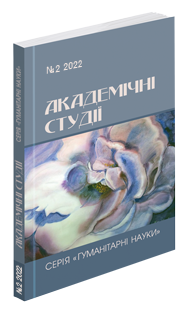Abstract
The paper analyses the linguistic means used to denote the military of the Ukrainian army within the discourse of the Russia-Ukraine armed conflict. The military conflict that has been ongoing since 2014 has affected the linguistic picture of Ukrainian society. In the media space, a complex of linguistic means is formed, reflecting the armed and information confrontation. A special role is played by linguistic units that objectify the positive image of a warrior of his own army. The purpose of the paper is to model the structure of the lexical-semantic group “WARRIORS” in the discourse of the Russia-Ukraine information war. For this purpose, the texts of Ukrainian information portals and pages in social networks are analysed, as a result of which 90 lexemes and collocations to denote the military of the Ukrainian army are recorded. As a result of the analysis, the structure of the lexico-semantic group “WARRIORS” as a component of the “DEFENDER” microfield within the lexical-semantic field “WAR” is modelled. A semantic-cognitive analysis of the DEFENDER and WARRIOR concepts in the discourse of information war is carried out. The results of the analysis show that the linguistic designation of the defender in the modern Ukrainian media discourse coincides with the traditional picture of the world of speakers, according to which the warrior of his own army is endowed with exclusively positive qualities. Within the lexical-semantic group “WARRIORS” two types of microgroups are distinguished: for designations of general concepts and specialized designations – with approximately the same set of constituents – 46 and 44 units, respectively. In each of these types, 10 lexical-semantic microgroups are allocated. It is established that in the analysed media space both ready-made nominative units and morphological innovations are used to denote the defender. The use of paraphrases and metaphorical collocations is common. The influence of socially important events on the choice of language units for the designation of the military is also recorded.
References
Вільчинська Т. Вербалізація бінарної концептуальної опозиції «захисник – ворог» (на матеріалі газетних текстів). Медіапростір. 2017. Вип. 10. С. 59–65.
Джаралла А. Ю. Інформаційне висвітлення конфліктів у Перській затоці та його еволюція (1991-2004 рр.): автореф дис. … канд. наук із соц. комунікацій: 27.00.04. Запоріжжя, 2008. 16 с.
Єфименко О. Словосполуки з лексемою «війна» в мові української періодики. Psycholinguistics. 2017. Вип. 22 (2). С. 50–61.
Кирилюк О. Л. Мова постфольклору в дискурсі інформаційної війни: концептуальні метафори, меми- концепти, іллокутивний зміст. Innovative pathway for the development of modern philological sciences in ukraine and eu countries: Scientific monograph. Volume 2. Riga, Latvia: “Baltija Publishing”, 2022. Pp. 212– 242. DOI: 10.30525/978-9934-26-196-1-31
Кирилюк О. Л. Формування образу захисника в умовах інформаційної війни: лінгвокогнітивний аспект. Львівський філологічний часопис. 2020. № 8. С. 90–96. DOI: 10.32447/2663-340X-2020-8.14
Компанцева Л. Феномен психологічних операцій як концепт і дискурс (за матеріалом безпекових лінгвокультур НАТО та Російської Федерації). Psycholinguistics. 2020. Вип. 27 (2). С. 174–194.
Кочерган М. П. Загальне мовознавство. Київ: Академія, 2003. 464 с.
Підкамінна Л.В. Моделювання концепту «воїн» у сучасних українських ЗМІ. Науковий часопис НПУ ім.М.П. Драгоманова. Філологічні науки (мовознавство і літературознавство). 2017. Вип. 7. С. 105–111.
Почепцов Г. Когнитивные войны в соцмедиа, массовой культуре и массовых коммуникациях. Харьков: Фолио, 2019. 313 с.
Прищепа Г. “Мова ненависті” як лінгвістичний маркер “гібридної війни”. Psycholinguistics. 2017. Вип. 22 (2). С. 98–112.
Яремчук А. Мовна картина світу – концептуальна картина світу – художня картина світу: параметричні ознаки й характер співвідношення. STUDIA UKRAINICA POSNANIENSIA. 2020. Vol. VIІ І/1. P. 69–76.
Etaywe, A, Zappavigna, M. Identity, ideology and threatening communication An investigation of patterns of attitude in terrorist discourse. Journal of Language Aggression and Conflict. 2022. Vol. 10 (2), P. 315–350. https://doi. org/10.1075/jlac.00058.eta
Fabiszak М. A Conceptual Metaphor approach to war discourse and its implications. Poznan: Wydawnictwo Naukowe UAM. 2007. 270 p.
Lakoff G. Metaphor and war: The metaphor system used to justify war in the gulf. Journal of Cognitive Semiotics. 1992. Vol. IV(2). P. 5–19.
van Dijk T. A. Politics, Ideology, and Discourse. Encyclopedia of Language & Linguistics. 2006. p. 728˗740. doi: 10.1016/B0-08-044854-2/00722-7

